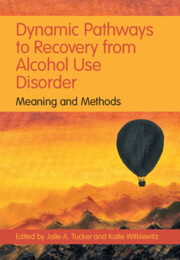Book contents
- Dynamic Pathways to Recovery from Alcohol Use Disorder
- Dynamic Pathways to Recovery from Alcohol Use Disorder
- Copyright page
- Dedication
- Contents
- Figures
- Tables
- Contributors
- Foreword
- Preface
- Acknowledgments
- Introduction
- Part I Micro Level
- Part II Meso Level
- 9 Natural Recovery from Alcohol Use Disorder
- 10 Individual Behavioral Interventions to Incentivize Sobriety and Enrich the Natural Environment with Appealing Alternatives to Drinking
- 11 Family and Social Processes in Recovery from Alcohol Use Disorder
- 12 Community-Based Harm Reduction Approaches for Alcohol Use Disorder
- 13 Use of Mobile Technology to Understand and Improve Recovery from Alcohol Use Disorder
- 14 Studying Recovery in the Social Context
- 15 Measuring Substance Use Contexts and Substance-Free Reinforcement
- Part III Macro Level
- Conclusions and Future Directions
- Index
- References
9 - Natural Recovery from Alcohol Use Disorder
Patterns, Contexts, and the Behavioral Economics of Change
from Part II - Meso Level
Published online by Cambridge University Press: 23 December 2021
- Dynamic Pathways to Recovery from Alcohol Use Disorder
- Dynamic Pathways to Recovery from Alcohol Use Disorder
- Copyright page
- Dedication
- Contents
- Figures
- Tables
- Contributors
- Foreword
- Preface
- Acknowledgments
- Introduction
- Part I Micro Level
- Part II Meso Level
- 9 Natural Recovery from Alcohol Use Disorder
- 10 Individual Behavioral Interventions to Incentivize Sobriety and Enrich the Natural Environment with Appealing Alternatives to Drinking
- 11 Family and Social Processes in Recovery from Alcohol Use Disorder
- 12 Community-Based Harm Reduction Approaches for Alcohol Use Disorder
- 13 Use of Mobile Technology to Understand and Improve Recovery from Alcohol Use Disorder
- 14 Studying Recovery in the Social Context
- 15 Measuring Substance Use Contexts and Substance-Free Reinforcement
- Part III Macro Level
- Conclusions and Future Directions
- Index
- References
Summary
Although treatment samples dominate research on recovery from alcohol use disorder (AUD), natural recovery is the dominant recovery pathway in the population with problems. This chapter summarizes key natural recovery research findings: (1) Most individuals with AUD never receive treatment; associations among AUD severity, help-seeking, and recovery are complex; and influences on help-seeking and behavior change are not wholly redundant. (2) Drinking practices and improved functioning are not highly correlated, indicating domains for defining recovery require expansion. (3) Moderation outcomes are more common in natural than treatment-assisted recovery attempts, in part because most treatments emphasize abstinence. (4) Compared to abstinence and relapse, moderation outcomes of natural recovery attempts are associated with distinct variability in drinking practices and monetary spending patterns that increase access to valued non-drinking rewards. This variability in AUD problem severity, help-seeking, and recovery patterns merits consideration in defining recovery and guiding services across the AUD spectrum.
Keywords
- Type
- Chapter
- Information
- Dynamic Pathways to Recovery from Alcohol Use DisorderMeaning and Methods, pp. 159 - 178Publisher: Cambridge University PressPrint publication year: 2022

